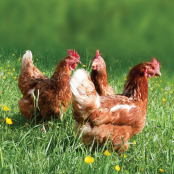Organic Poultry

While organic may be the smaller of the poultry systems; it is growing year on year. Irish organic egg production has increased in recent years to a market share of 3%. Elaine Leavy, Organic Specialist & Rebecca Tierney, Poultry Advisor have advice on the requirements for setting up organic poultry
Organic Poultry (PDF)
Introduction
Poultry production is broadly divided into two distinct production sectors – meat and eggs. Poultry production is carried out under varying intensities – intensive, free range, barn and organic. While organic may be the smaller of the poultry systems; it is growing year on year. Irish organic egg production has seen an increase in recent years with a market share of 3% valued at €4 million.
Organic regulation and certification
 A major factor distinguishing organic farming from other approaches to sustainable farming is the existence of internationally acknowledged standards and certification procedures. The standards for organic production within the European Union are defined and enshrined in law by European Council (EC) Regulation 834/2007. In Ireland, the Department of Agriculture, Food and the Marine (DAFM) is the competent authority for regulating the organic sector and ensuring that the obligations and requirements of Regulation 834/2007 as amended are adhered to.
A major factor distinguishing organic farming from other approaches to sustainable farming is the existence of internationally acknowledged standards and certification procedures. The standards for organic production within the European Union are defined and enshrined in law by European Council (EC) Regulation 834/2007. In Ireland, the Department of Agriculture, Food and the Marine (DAFM) is the competent authority for regulating the organic sector and ensuring that the obligations and requirements of Regulation 834/2007 as amended are adhered to.
All potential producers of organic poultry must register with one of the organic certification bodies (OCBs) in order to produce and market a product to organic standards. The two Irish OCBs are the Organic Trust and the Irish Organic Association (IOA). These bodies are approved by the DAFM to provide a licensed inspection and certification scheme. For full interpretation of the rules and regulations governing organic poultry farming, it is essential to study the ‘Organic Food and Farming Standards in Ireland’ document.
Feed
 The overall feed for the flock must be of organic origin and certified organic. Nonorganic protein feed is presently permitted to be fed up to 5% on an annual allowance. No synthetic amino acids or genetically modified raw-feed ingredients are permitted to be included in the diet. All poultry must have access to insoluble grit. This helps to digest food in the gizzard of the bird.
The overall feed for the flock must be of organic origin and certified organic. Nonorganic protein feed is presently permitted to be fed up to 5% on an annual allowance. No synthetic amino acids or genetically modified raw-feed ingredients are permitted to be included in the diet. All poultry must have access to insoluble grit. This helps to digest food in the gizzard of the bird.
Sourcing stock
If certified organic chicks are not readily available, there is presently a derogation process in place where, if a producer is unable to source organic chicks, they must seek prior approval from their OCB for the purchase of non-organic chicks. Similar to layers, if organic birds are not readily available for meat production, prior permission must be applied for and approval granted from the OCB for the purchase of non-organic chicks. The Organic Standards require that these birds are grown organically for a lifespan of at least 81 days.

Housing
Another major difference between free range and organic farming is the stocking density which must be adhered to. By organic standards, birds are granted more in both housing and range. Access to outside pastures is required. The stocking densities required for all organic poultry types are outlined in Table 1. For all birds, at least one third of the floor must be solid, i.e., not slatted. This solid flooring must be covered with a suitable litter material. For broilers, the house is of barn type with the floor covered with a suitable litter material. Birds must be provided with a maximum of 16 hours of light per day. This can be supplemented with artificial light as required. They must receive a continuous nocturnal rest period without artificial light for a minimum of eight hours.
Biosecurity
 Biosecurity is a set of management practices which reduce the potential for the introduction and spread of disease onto and between farms. Good biosecurity is vital to ensure flock health and welfare is maintained, and that disease will not impact the productivity or profit of the farm.
Biosecurity is a set of management practices which reduce the potential for the introduction and spread of disease onto and between farms. Good biosecurity is vital to ensure flock health and welfare is maintained, and that disease will not impact the productivity or profit of the farm.
Range
Birds must have access to outside pastures and appropriate shelter is required. They must have continuous and easy daytime access to pasture/range for at least one-third of their lives. The range should be:
- mainly covered with vegetation;
- divided into rotational paddocks to minimise erosion;
- free draining; and,
- kept under control via topping during the summer.
Range shelters must be provided whether artificial (man-made shelters) or natural (trees, shrubs).
Veterinary practices
Organic producers are not permitted to use any preventative veterinary treatments. However, if a specific illness occurs within the flock and treatment is necessary, birds will be treated. This has to be done with the supervision of a veterinary surgeon. Longer withdrawal times are adhered to. Beak trimming of birds is not allowed as a routine management procedure.
Fact sheet produced by Elaine Leavy, Organic Specialist and Rebecca Tierney, Poultry Advisor.
If you liked this Fact Sheet you might like to read some more Rural Development Factsheets here
Find out more about Organic Farming here: Organics

